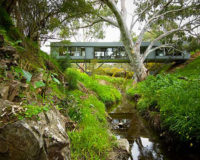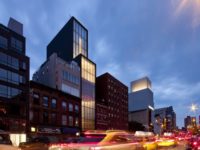The early 21st century may be remembered as the time America began to crumble. While the assertion may lapse into hyperbole, the collapse of the I-35W Mississippi River Bridge at Minneapolis on August 1 focused our attention on the perilous condition of our structural underpinnings, and we found them weak. While the experts continue to evaluate exactly what went wrong in Minneapolis/St. Paul, this disaster follows in the wake of other spectacular failures in other cities.

Remember Boston in July 2006? We are only now fully sorting through the forensic evidence surrounding the malfunction of 20 ceiling anchors that dropped 10 precast-concrete panels weighing 26 tons into the Interstate 90 tunnel. Just this summer in New York, the streets have blown up (a steam pipe explosion at the intersection of Lexington Avenue and 41st Street on July 18) and the underground drowned (a deluge on August 8 virtually shut down Manhattan mass transit on a busy workday). Apocalypse Now, or are we fraying at the seams? Patricia Galloway, former president of the American Society of Civil Engineers (ASCE), writing about infrastructure on enr.com, wrote, “(Can we) assure those using our infrastructure that they are not risking their lives simply by using it?”
According to the ASCE, America’s infrastructure requires a massive infusion of capital and energy. In 2005, for its Infrastructure Report Card, a sobering document, the nation’s systems received a total grade of D+. The assessment cited the condition of the 590,750 bridges in the system (which they estimate would take $9.4 billion per year just to maintain “system conditions so costs do not rise.”) Additionally, the report cited our battered flood control, which is operating outside “historic patterns”; power, which requires a “smart” grid to reallocate energy based on supply and demand; money for improved water treatment; and additional capacity for airports, straining under 4.3 percent annual growth. The full list included schools, highways, security, dams, waterways, recreation, rail, roads, and waste-management investments. The cost to fix what’s broken or absent? The total tab hits the astronomical figure of $1.6 trillion—a surreal amount.
The problem of maintaining infrastructure lies in its visibility. With few exceptions, you cannot see the source of your drinking water, and you may not know the origins of your electrical power. Politicians recognize that voters rarely get excited about the services, so rarely tout improvements, preferring to champion new pork barrel projects, such as Alaska’s Gravina Island Bridge project, the so-called, “Bridge to Nowhere.” California offers one strong exception to the rule, where Governor Schwarzenegger has promoted multibillion dollar bond issues for schools, water resources, and flood protection that will aid California’s inevitable growth.
If we lack political will, and the public does not recognize the severity of the crisis, then where do architects fit into this equation? While we may not control the outcome of engineering solutions, we can effectively shape the texture, experience, and fundamental programmatic elements of the built environment. Debra Smith, AIA, a planner employed by Kansas City, Missouri, acknowledges that we may have turned over much of the shape of our communities to engineers and transportation officials, but our roads and bridges “are designed for optimum efficiency, not necessarily for compatibility of adjacent land uses or the way communities look.” She says architects must actively promote multiple access routes throughout an urban environment, not just multiple lanes of traffic, and that we can help encourage the planning for our cities and small towns to become places friendly for walking or biking. Uniquely, we think holistically and can champion communities that promote public health, not merely wide highways.
In some cases, our contributions to infrastructure shine. For the San Francisco-Oakland Bay Bridge replacement, one of this nation’s largest, the team includes architect Donald MacDonald, who has made bridge design a critical subset of his practice. Many of our greatest successes professionally include avoidance. The stories of elevated highways, proposed and actual, that architects have helped the public to better understand and thus eliminate, includes the proposed Martin Luther King elevated parkway in Des Moines. A three-dimensional model clearly illustrated its detrimental scale to business leaders, who insisted it be dropped to an on-grade solution in 2003. Today, in Honolulu, architects are at the forefront of the opposition to raised light rail, which threatens to block the historic downtown from its unparalleled beachfront. The list goes on.
At the meta-level, architects are engaging with their communities as smart thinkers. If our nation’s infrastructure requires attention, we can join with our allied professionals, including engineers and planners, and our own hometowns. Yes, we need updated highways, but not if they encourage sprawl. Yes, we need better bridges, but not necessarily more lanes delivering more people farther out into the countryside. Infrastructure continues to crumble and must be repaired, but ultimately, our concern equally spans the bridges and the communities linked together on each side.
If you wish to write to our editor-in-chief you can email him rivy@mcgraw-hill.com.






Post a comment to this article
Report Abusive Comment